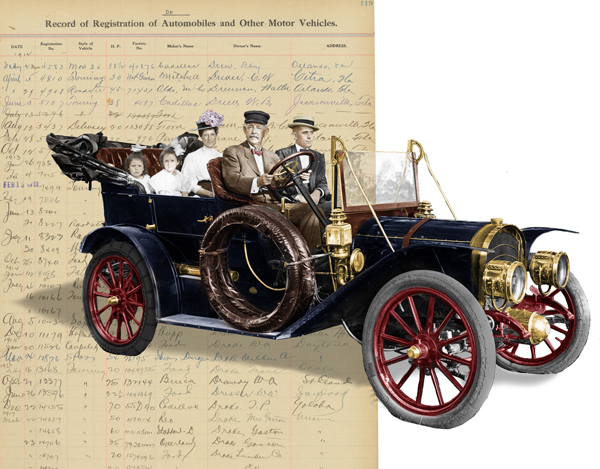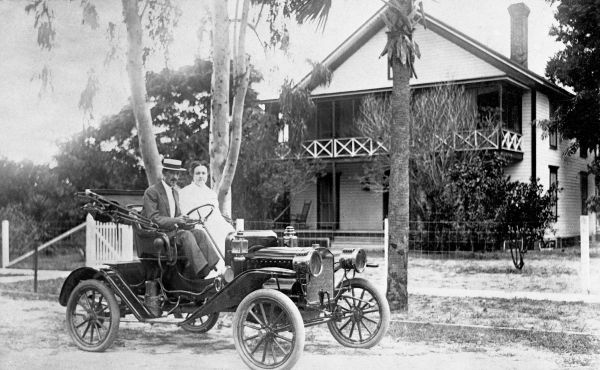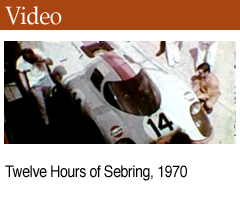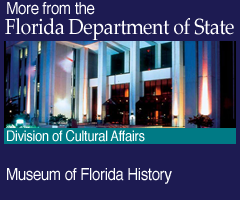Early Auto Registrations, 1905-1917
About These Records

This collection contains Florida's first automobile registrations, which were recorded by the Florida Department of State between 1905 and 1917. Each registration, which was handwritten in a ledger, indicates the name and post office address of the registrant plus the manufacturer, style, horsepower and factory number of the vehicle. Each entry was dated and assigned a unique registration number, which was sent to the registrant on a certificate.
These records help illustrate how profoundly the automobile transformed Florida in the early 20th century as well as how much the automobile itself changed over the same period. Some of the earliest registrations in the records are for steam-powered and electric cars, and many of the entries are for cars made by companies like the Sears & Roebuck Corporation, the National Sewing Machine Company, and the Locomobile Company of America. Old recognizable brands, like Ford, Cadillac and Olds[mobile], can be found throughout the collection as well.
Local historians can use these records to identify the earliest automobile owners in a given Florida community. Genealogists will find them useful for determining whether and where their ancestors may have registered automobiles in Florida during the 1905-1917 period.
Using the Collection
These automobile registrations are organized chronologically in two volumes, with some overlap around the 1912-1913 period. To look for a specific person, family, town or make or model of vehicle, try searching in both volumes. Click or tap the link for a volume to open it, and then use the Name Index tab to sort or search the registrations.
- Florida Automobile Registration Record (Volume 1), 1905-1913
- Florida Automobile Registration Record (Volume 2), 1912-1917
Background
A handful of "horseless carriages" appeared in Florida in the 1890s, but machines going by the name "automobile" first began appearing in the Sunshine State around 1900. That year, Edward Manrara purchased Tampa's first auto, which had a gasoline-fueled engine but was propelled by steam. A newspaper editor in Tallahassee wrote later in 1900 of seeing an automobile pass through town for the first time. Gainesville's first auto arrived in 1905, and the first car to pass through Fort Pierce did so in 1907 while en route from Jacksonville to Miami.

No law existed to regulate the use of automobiles on public roadways at first, but this state of affairs was bound to come to an end. Speed tests were popular events and tended to draw large crowds, but unless they were adequately announced and prepared for, they could be dangerous and disruptive to normal business. Horses were often frightened by the new machines, and no uniform procedures existed to aid pedestrians trying to cross city streets unscathed.
State Representative Edward L. Wartmann, of Citra, in Marion County, sought to bring some order to this chaotic situation. In 1905, he introduced a bill in the House that would require automobile owners to register their vehicles and outfit them with safety equipment as well as follow some basic rules for driving. Wartmann based his bill in part on the automobile laws already in force in the state of New York. The full text of the law as passed by the 1905 Legislature is available on the Registration Laws page, but the following were the main requirements of the act:
- Every automobile had to be registered with the secretary of state, and the certificate of registration had to be present with the vehicle at all times during its use.
- The vehicle's registration number had to be displayed on a tag in Arabic numerals of not less than 3 inches long and 2 inches wide.
- Every vehicle operating on public roadways had to have a bell, horn or whistle available as a signal as well as two "lamps" to be used for illumination between sunset and sunrise.
- Drivers had to abide by a "proper and reasonable" statewide speed limit.
- Motorists had to give a signal when approaching horses or other draft animals and were obligated to immediately stop if given a signal to do so by someone riding or driving said animals.
- Boards of county commissioners were empowered to set aside times for speed tests or races on public roadways, which drivers had to adhere to.
It may seem odd that the secretary of state was selected as the official responsible for supervising the registration of automobiles, but prior to this there were no other private forms of transportation that required registration. Common carriers, like railroads and steamship companies, were regulated at the state level, but carriages, wagons and horses were not registered with the state government at all. Consequently, the automobile was a new frontier not only for transportation, but for governmental regulation as well.
The secretary of state was responsible for registering vehicles until 1917, when the duty was transferred by law to the Comptroller's Office. Unfortunately, the individual registration records from that agency's tenure as automobile registrar do not appear to have survived. Annual registration totals are listed, however, in the Comptroller's annual reports, which are available in print and online.

 Listen: The Latin Program
Listen: The Latin Program


